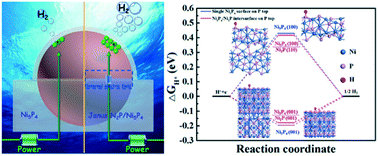Fabrication and study of the synergistic effect of Janus Ni2P/Ni5P4 embedded in N-doped carbon as efficient electrocatalysts for hydrogen evolution reaction†
Abstract
The integration of structural design and compositional modulation has been a hotspot for the optimization of electrocatalytic properties due to their synergistic effect. However, the details of this synergistic effect still lacks deep study. Herein, we fabricated an Ni2P/Ni5P4 electrocatalyst with a Janus nanostructure embedded in N-doped carbon through a controllable phosphidation approach. The as-obtained hybrid catalyst realized an overpotential of 104 mV and Tafel slope of 38.5 mV dec−1, which were smaller than that of the single Ni2P and Ni5P4, at a current density of −10 mA cm−2 in 0.5 M H2SO4 electrolyte. To reveal the reasons for the promotion of electrocatalytic properties, the synergistic effect was analyzed with the difference charge density (DCD), density of state (DOS), ΔGH*, and strength of the internal electric field (IEF) on the interface between Ni5P4 and Ni2P. The results indicated that the composite structures could optimize the ΔGH* due to the change in the DOS instead of DCD. Further calculations indicated that the composite structure could modify the effective electric field, which is often overlooked and may be the reason for the change in the DOS. This study provides new insight for designing multi-component catalysts and deeply illuminating a part of the synergistic effect for high-efficiently electrocatalytic activities.

- This article is part of the themed collection: 2020 Catalysis Science & Technology Hot Articles


 Please wait while we load your content...
Please wait while we load your content...